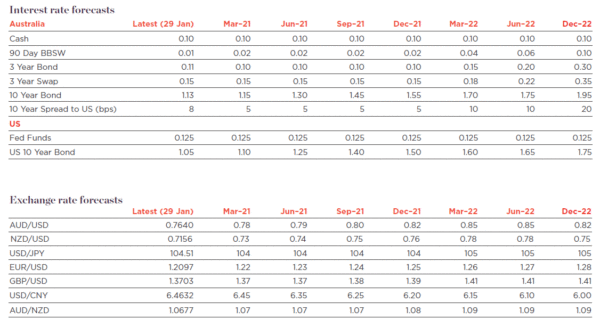The RBA Board meets next week on February 2.
Earlier this week in an extensive report “What Next for the RBA” we made the following points:
- RBA will extend the Quantitative Easing (QE) program by a further $100 billion with the announcement coming at either the February Board meeting or, more likely, the March Board meeting.
- RBA will reshape the Term Funding Facility (TFF) when the current scheme expires end June to narrow the focus on specifically boosting business lending.
- The yield curve control policy (YCC) will be continued through 2021 with a review expected early in 2022.
- The Governor is expected to announce a more optimistic growth and employment outlook – to be confirmed in the Statement on Monetary Policy (SOMP) on February 5 – with the unemployment forecast for end 2021 being lowered from 6.5% (November SOMP) to 6.0%; growth in 2020 to be upgraded from –4% to –2% although the 2021 growth forecast to be “shaved” from 5% to 4%. Those forecasts would be in line with Westpac’s current forecasts and consistent with a return to pre-Covid levels of activity by the June quarter 2021.
While the SOMP does not include specifi c global growth forecasts we would expect the Governor and the commentary in the SOMP to refer to a brighter outlook for global growth than in the November SOMP. In particular the outlooks for both US and China are likely to be boosted.
In that regard we have been monitoring our medium term forecasts for both interest rates and the AUD.
Back on August 21 (AUD) we last changed our forecasts for AUD to USD 0.75 by end 2020 and USD 0.80 by end 2021 (from USD 0.72 and USD 0.76 respectively).
On November 20 we last changed our forecasts for the 10 year US bond rate by end 2021 to 1.2% from 0.8% (at the time the UST bond rate was 0.82%).
Those forecast revisions were based on a stronger likely profi le for global growth and commodity prices than had been previously envisaged.
The key catalyst was the improving outlook for vaccines; ongoing momentum in the Chinese economy; and (for the interest rates) the likely boost to US confi dence with the uncertainty around the election having cleared.
The forecast changes were prescient since the interim (end 2020) “targets” were “over achieved ” for both bond rates and the AUD – US Treasuries reached 1.1% and AUD around USD0.775.
Since then markets have settled back with AUD at USD0.765 and US Treasuries around 1.05%.
But a number of key developments are pointing to the need for a further upscaling of our forecasts.
Firstly, while, back in August, we were extremely positive about momentum in the Chinese economy through 2020 and a maintenance of solid growth in 2021 we have been surprised by the sustained elevation of key commodity prices (particularly iron ore). Our forecasts back in August entailed a moderation in iron ore prices but from a much lower base (USD 120 per ton) than we see today (USD156) and while we expect a supply response will lower iron ore prices by year’s end the forecast end point (USD 130) is much higher than our August forecast of USD 80.
Although in recent days we have seen some “correction” in key commodity prices (iron ore down 9%; copper down 5%; zinc down 11%), associated with some policy tightening in China we do not see this as a precursor to a damaging turning point in commodity prices.
The other key development has been the change in the political balance in Washington. With the Democrats now controlling the Senate and Budget related bills able to be passed with a simple majority prospects for a very signifi cant fi scal stimulus (up to USD1.9 trillion) are encouraging.
A large Government stimulus and a successful rollout of vaccines are the two most critical swing factors for the outlook for the US economy. With the new administration being much more organised and determined in their approach to the vaccine rollout we see scope to lift the growth outlook for the US economy in 2021.
From a forecast of 3.7%yr for 2021 in December last year we are now expecting US growth in excess of 5% (annualised) in the fi nal three quarters of 2021.
Although US 10 year bond rates have fallen back to 1.05% (from 1.1%) we consider that the path of rates in 2021 will be dominated by the improved growth environment.
On the other hand, the improving growth momentum will not be suffi ciently surprising to raise any real response from the Federal Reserve with the current pace of QE (USD 120 billion per month) continuing through the year.
An improving US outlook (associated with government support and successful vaccine roll out) is likely to be a common theme across other regions supporting rising optimism for the world economy.
These are supportive conditions for the AUD which attracts global “risk on” interest when optimism prevails in the world.
The RBA’s QE program which we have already discussed is unlikely to have any further market impact. We expect the program to be “maintained” at $100 billion, as a policy neutral stance.
Recall that when the market fi rst sensed the prospect of the initial QE program the spread between AUD and USD bonds fell from around 30 basis points to slightly negative. That diff erential largely held although has recently widened as markets respond to some speculation that RBA will reduce its commitment to QE.
AUD fell back from USD 0.73 to USD 0.70. Those responses were consistent with a policy easing. The extension of the program will be policy neutral. Any (unlikely) move to scale back the program would boost AUD yields and the AUD.
Only increasing the program would force downward pressure on the AUD and yields. Westpac thinks that an increase in the QE program is extremely unlikely.
In line with the thinking set out above we have raised our forecast for 10 year US Treasuries by end 2021 from 1.2% to 1.5%. In turn, given the expectation that the RBA will maintain its QE program but scale it back in October to $50 billion we expect the bond spread to settle at around 5 basis points by year’s end pushing AUD 10 year bond rates out to 1.55% (from the November forecast of 1.25%).
With a steepening global yield curve; our outlook for commodity prices, which has been revised up from our forecasts back in August; likely ongoing solid momentum in China; we are also raising our August forecast for AUD to USD0.82 (from USD0.80) by end 2021 and USD0.85 by mid-2022 (from USD0.82).
As usual there are always risks principally related to the global vaccine rollout; policy in China; and the US fi scal stimulus.
For Australia we are less uncertain, with fiscal and monetary policy likely to remain supportive of growth throughout 2021.














